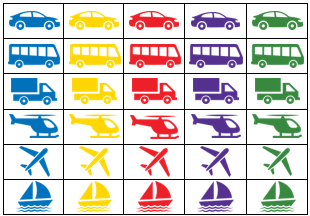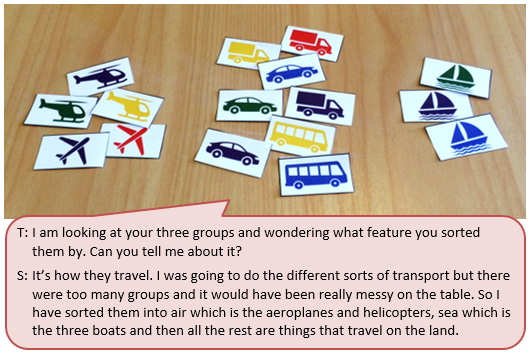The purpose of this activity is to engage students in sorting shapes by a common feature.
This activity assumes the students have experience in the following areas:
- Describing how shapes are alike and not alike.
- Matching shapes by appearance, using features such as global appearance, number of sides/corners, colour, and size.
- Sorting shapes by common features.
- Using mathematical language to describe similarities and differences in shapes, such as “straight/curvy”, “corners (sharp/blunt)”, “side”, “large/small”, “red, yellow, blue,…”
The problem is sufficiently open ended to allow the students freedom of choice in their approach. It may be scaffolded with guidance that leads to a solution, and/or the students might be given the opportunity to solve the problem independently.
The example responses at the end of the resource give an indication of the kind of response to expect from students who approach the problem in particular ways.
Here are some different forms of transport.
Show how they could be sorted into groups that share common features.
Explain what the members of each group have in common.
Note to teacher: This activity may be carried out with material objects to sort, or images on cards. A printable page of transport images for this use is provided in the copymaster, we recommend using a random selection of about half of the images.
The following prompts illustrate how this activity can be structured around the phases of the Mathematics Investigation Cycle.
Make sense
Introduce the problem. Allow ākonga time to read it and discuss in pairs or small groups.
- What do you think the problem is about?
- What do you need to do?
- How are the cards alike and how are they different?
- What part of the problem could you get started with?
- Can you rephrase the problem in your own words? (Which objects are like each other?)
Plan approach
Discuss ideas about how to solve the problem. Emphasise that for now you want ākonga to say how they would solve the problem, not to actually solve it.
- What strategies can you use to get started?
- What different features could you use to sort the cards?
- How will you organise the cards, so they do not get mixed up?
- How will you record what you have done so you can sort the cards in a different way? (Digital photographs are useful).
- Can you try some ideas out and check if they work?
Take action
Allow ākonga time to work through their strategy, and find a solution to the problem.
- Which cards belong together?
- What is similar about those cards?
- Are there any other cards that belong in the same group? How do you know?
- Can you make another group from some of the cards that are left over?
- Can you find a group for all the remaining items?
- What other ways could you sort the same set of cards?
Convince yourself and others
Allow ākonga time to check their answers and then either have them pair share with other groups or ask for volunteers to share their solution with the class.
- What is your solution?
- How does your solution answer the question?
- How can you explain to someone else how you sorted the cards?
- Can you justify why some cards have been put in the group they are in?
- Is your solution the only possible way to sort the cards?
- What might you do differently next time? What other ways to sort can you find?
- How is sorting important in other things that you do?
Examples of work
Work sample 1
The student sorts a collection of cards into groups by colour and resorts the cards by a different feature, mode of transport.
Click on the image to enlarge it. Click again to close.
Work sample 2
The student sorts the cards using a criterion that they create, the environment of travel (air, water, land).

